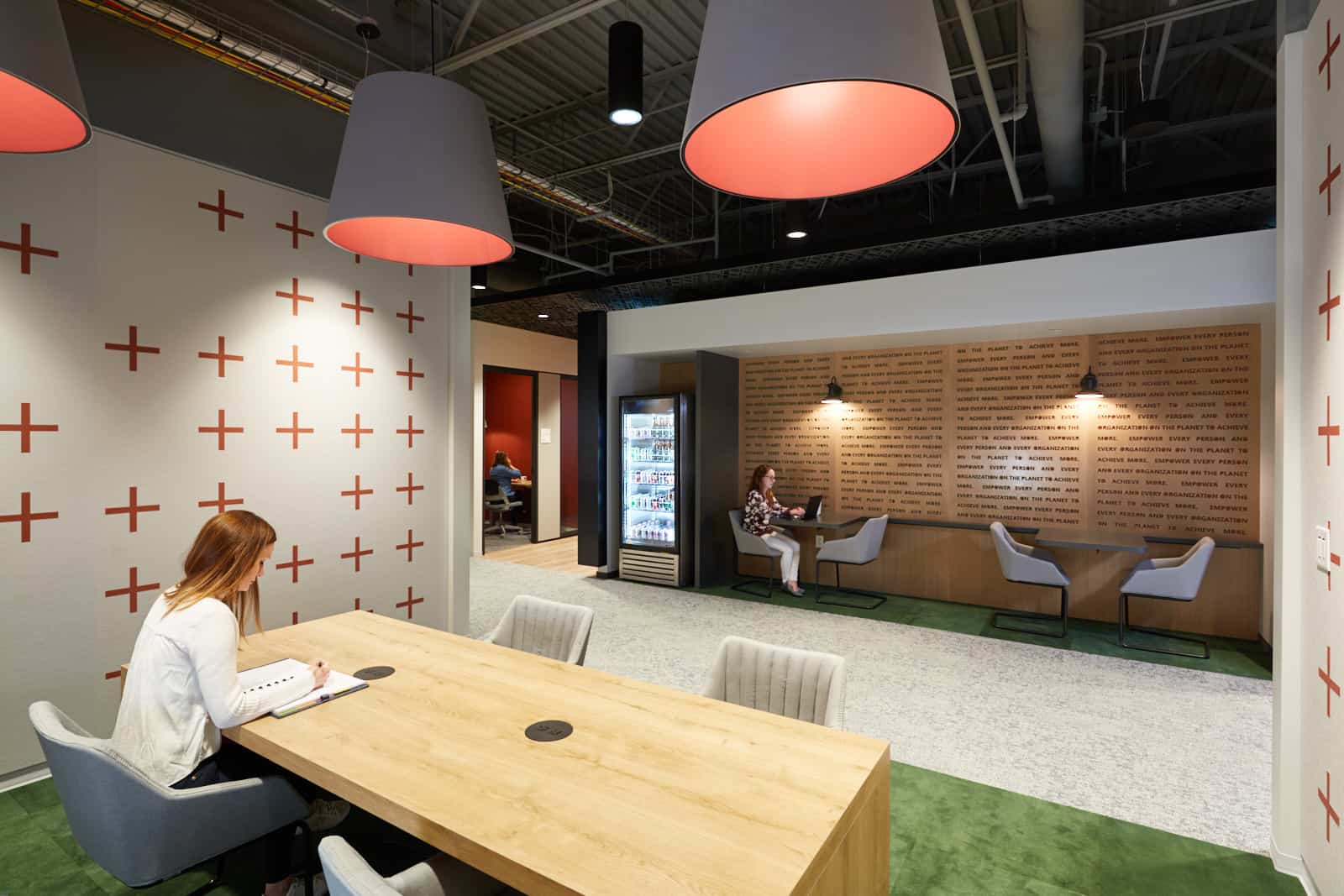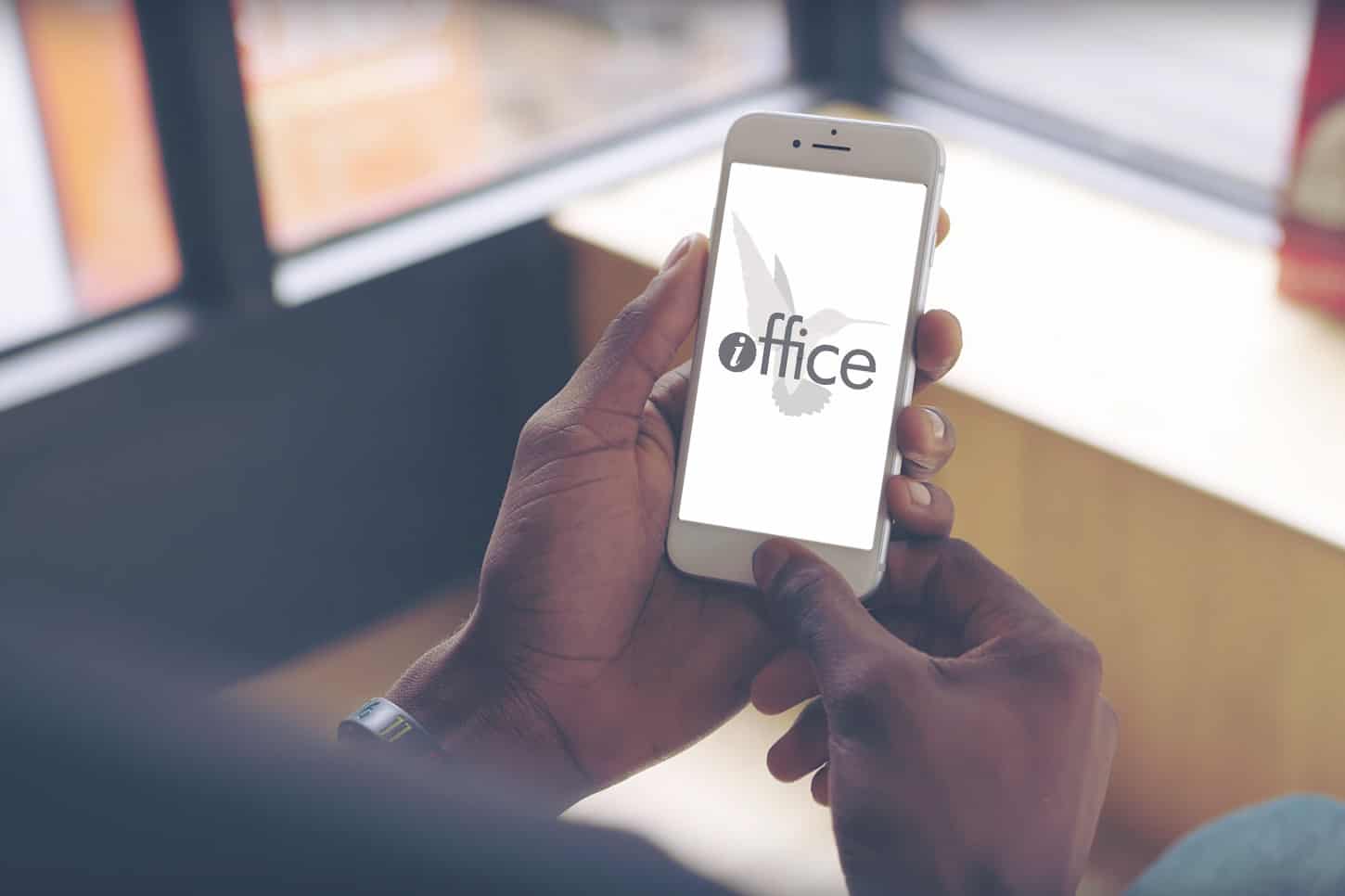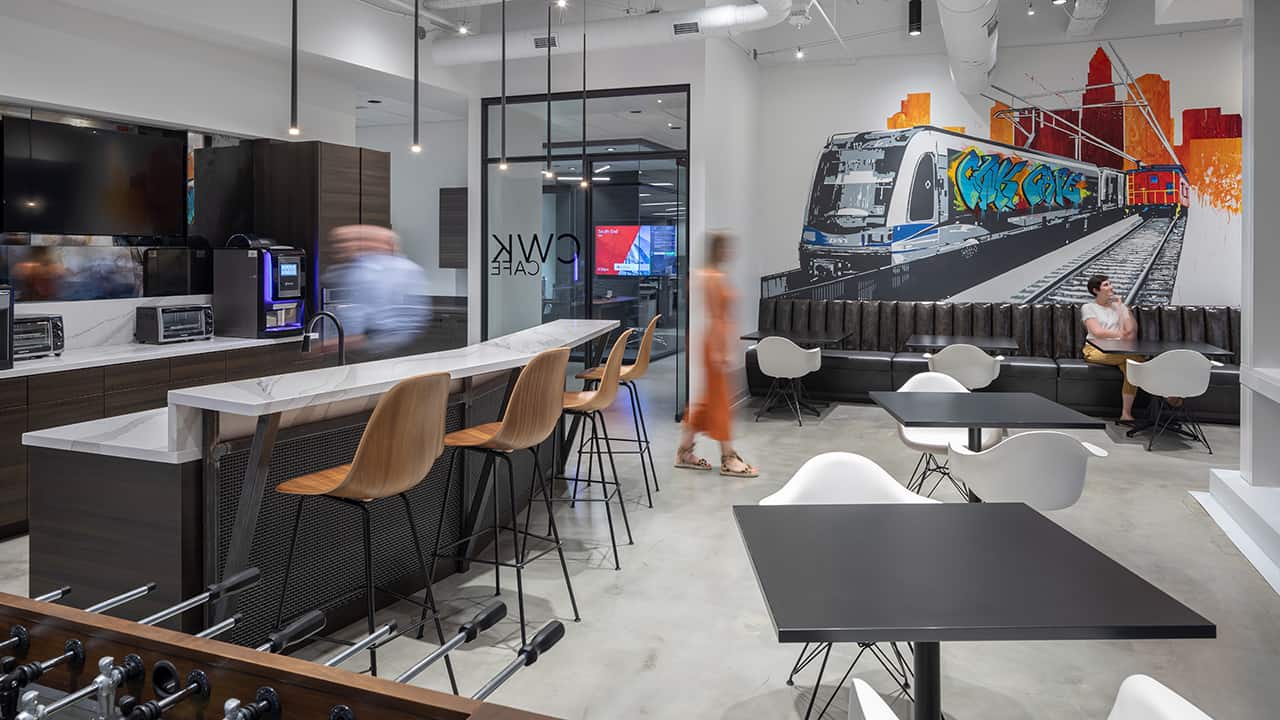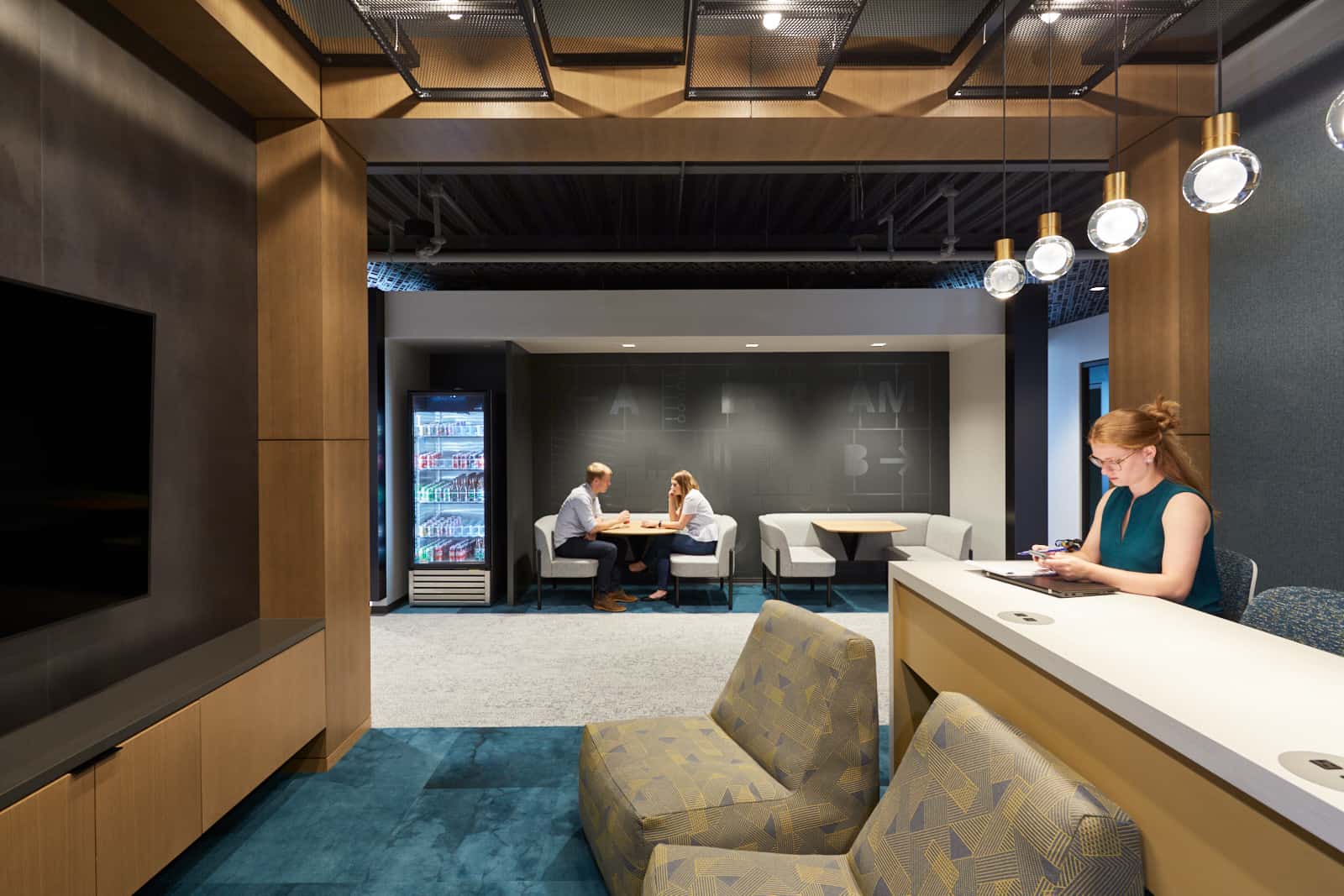Reprinted: CoreNet Global Hack-A-Thon, Team 4
The COVID-19 event will be a catalyst for change and fundamentally alter the way we design and manage the workplace.
Looking beyond this crisis, the workplace of the future will leverage technology to provide a safer and smarter workplace while enhancing performance and experience. Automation developed as a response to COVID-19 will leverage existing technologies, result in more rapid adoption of these technologies and spur advances in cellular communication, Smart Building tech, AI and robotics to create safer, higher-performing and more human-centric workplace environments.
The Technology Ecosystem that will support our autonomous workplace is made up of three layers, starting with digital interfaces such as mobile apps and sensors that occupants will interact with, to integrated data stores, and culminating in AI. The COVID-19 event will accelerate development and wider adoption of automated tools such as these, increasing the ability to improve the performance, management and customizability of buildings and workspaces while improving the health and convenience of the people using them.

From Evolution to Revolution
Although we have seen a migration of disconnected traditional technologies transition to a more converged, modern approach, much technology in the workplace has been limited to mass-market acceptance of tools with a lower cost of entry, with many available technologies not widely known about or not adopted for a variety of reasons, including the perceptions of prohibitive cost, and privacy issues.
After the events of 9/11 people traded privacy for a greater sense of security. We should expect the severity of C-19 event to affect similar tradeoffs, resulting in the evolution rof new building-integrated and consumer technologies, propelling workplace technologies into a “future state” as people trade hesitations for greater feelings of wellness and security. We anticipate a greater desire for technologies that feature convenience to users while delivering performance and management metrics to building owners.
Additionally, automation will play a significant role in improving resilience, both for the users by increasing levels of wellness, lowering stress and building greater immunity, and for buildings and spaces by integrating cascading levels of information, enabling the mitigation of harmful events and more effective management and building controls.
With all this in mind, we propose five ideas that will drive workplace automation:

IDEA 1: “In the Palm of My Hand” – Mobile First
The hallmark of the automated experience will be the convenience of marshaling and directing all this technology from your hand, whether via a mobile phone or through biohacking, where access and control will lie literally in the hand of the user.
Calendar and location services will provide on-demand recommendations for work settings, whether a conference room or quiet area based on the type of work being done, or the need to collaborate with people who may be in the office or remote.
In addition to increasing employee engagement by communicating events and providing real-time reminders, phones will provide access to important employee documents, and deploy surveys on workspaces, new work initiatives, on-boarding, training and social activities to enhance interpersonal connection in the workplace.
Last, no more badges, access cards or codes. Users will access spaces by deploying near-field communication (NFC), a contact-less technology designed to work across short distances, on their phones, or by scanning QR codes for facilities services, ad-hoc conference room reservations, and tech manuals for equipment.
IDEA 2: “At My Beck and Call” – Automated Convenience
A highly desirable feature of these technologies is the ability to expand the automated universe through intuitive design features for the user, making ease of use convenient and second-nature. Applets that integrate disparate devices will create a more seamless and holistic experience, all but eliminating the lack of continuity in workflows and other operations.
Artificial Intelligence (AI) and deep learning will continuously improve performance by updating algorithms as they process information.
Functions will be integrated using technologies that are similar to real-time traffic routing technologies, allowing people to reserve a spot in an elevator (a choke point post-COVID-19) and reminding them when it’s time to leave to catch it.
The convenience of palm-controlled automation will enable access to location-aware services for real-time campus info, like finding available parking and then dropping cars off at a fully automated parking deck. This will increase security for users by eliminating the need to walk through dark parking decks and controlling access to the automobiles. Without the need for two-way traffic in the deck, its footprint can be reduced to a third of a traditional parking deck, conserving both land and cost.
IDEA 3: “Whatever/Whenever I Want” – Personalization and Wellness
Automation in the workplace will enable mass customization and personalization of spatial and environmental qualities. The sensor rich environment will push data to occupants’ mobile devices, revealing the health of their immediate workspace and providing options based on lighting, temperature, sound and CO2 levels, not only in the suite but in the immediate workspace.
Workspace elements will play a part in individual wellness monitoring and recommendations. Chairs will reflect current biometric readings, like blood pressure, resting heartbeat and pulse-ox levels, and recommend a quick breathing break or a walk around the block to mitigate stress. Occupant preferences will be carried throughout the workplace, automating everything from desired morning coffee ingredients, to the setup of a workstation – complete with family photos displayed in electronic frames and preference for seat angle and sit/stand desk height – to lunch option suggestions based on personal health goals.
Technology will also support the occupant even when their personal choice is to work remotely. Remote workers will have robots that operate as physical proxies on site. Augmented Reality (A/R) and Virtual Reality (V/R) tools will allow these employees to interact with coworkers as if they were in the same room. Telepresence robots may roam the floors, providing the employee on the other end with serendipitous coworker interactions that drive collaboration. The transition between in-office and remote work will be seamless.

IDEA 4: “Protect the House” – Optimization and Sustainability
Building-integrated technologies provide the opportunity to gather even more granular data about the building performance which will drive future automation and further refine the user and owner experience. HVAC optimization and predictive maintenance will become more precise, with sensors on every building system capable of detecting vibrations, temperature or viral anomalies and alerting maintenance before system failure.
Cleaning programs will be driven by data, with occupancy levels identifying high-risk areas that need immediate attention. Robots will clean easy to maintain areas, freeing up human staff to clean more critical or complex areas. At night, these same robots will perform security sweeps, ensuring doors are secure and occupants are safe.
A/R will allow offsite maintenance experts to “see” what field technicians “see”, directing them to virtual manuals or virtually marking areas that need service. With a touch of the A/R screen, past service histories of the asset will appear on screen.
Cybersecurity requirements will continue to advance by requiring data encryption and automatic patching of the full technology stack of solutions, lifting the burden from RE&F staff who are not traditionally trained to address security concerns. Instead, this time can be invested into understanding the metrics that new autonomous buildings will be providing, supporting data driven operation while making commercial real estate a less attractive target for cyber criminals.
IDEA 5: “Position Me for the Future” – Predictive Analytics
The longest-term benefit of building and user-integrated automation is the ability for predictive analytics through multiple nested systems of use. Immediate convenience benefits are available for the user and building owner, certainly, but the most significant benefit is at the highest level – where a space/building/city block plugs into a civic module to enable large swaths of smart cities to develop.
Our sensor rich environment will better inform both occupants and building managers like never before and will usher in a democratization of information. AI will suggest in real time the best place to work based on individual historical preferences, actions and calendar entries. Building management systems will predict the optimum time to start cooling or heating the building based on employee arrival and departure trends and building characteristics.
Digital Twins will allow building managers to optimize their buildings across the portfolio with what-if scenarios overlaid on real-time data. Machine Learning (ML) will deliver insights by analyzing the vast volumes of data in a way that cannot be done by humans. Occupants can gain additional insights by creating personalized, customized dashboards of information and extracting ad-hoc reports from a diverse set of data sets.
A View to the Future
Robots and AI sound very sci-fi but the future isn’t all that far away. Our lives will become increasingly automated so we must be mindful of how we opt-in and apply automated capabilities. The importance of ethical data access and transparency is critical to building a trusting relationship between the employee and the employer.
The threshold will be when an employee opts-in in the recognition that they are receiving greater benefits, convenience and transparency about their employer and the operations of the company.
View our Beyond Workplace book on Issuu here.

